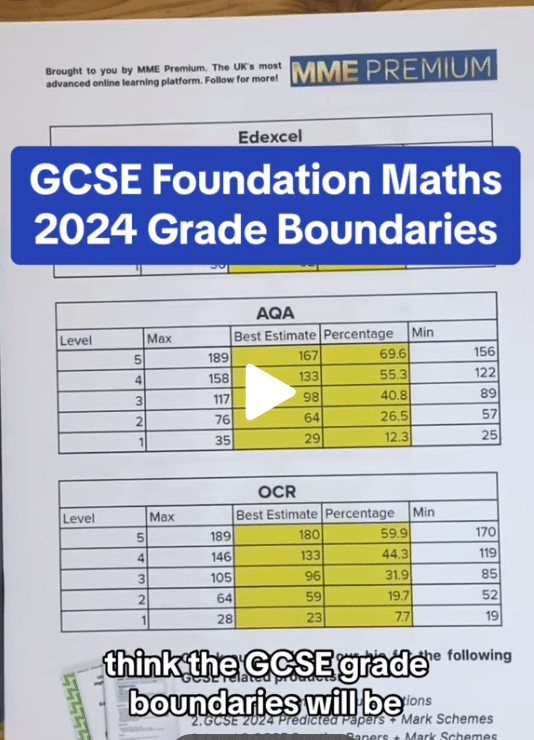Quadratic Formula
Quadratic Formula Revision
The Quadratic Formula:
The quadratic formula is a formula that you can substitute values into in order to find the solutions to any quadratic equation. This is just one method of solving quadratics, you will encounter more throughout the course.
Make sure you are happy with the following topics before continuing:
The Quadratic Formula
The quadratic formula is a formula that you can substitute values into in order to get the solutions to any quadratic equation.
x=\dfrac{-\textcolor{red}{b}\pm\sqrt{\textcolor{red}{b}^2-4\textcolor{blue}{a}\textcolor{Orange}{c}}}{2\textcolor{blue}{a}}
The \textcolor{blue}{a}, \textcolor{red}{b} and \textcolor{Orange}{c} values correspond to values in a quadratic equation, shown below
\textcolor{blue}{a}x^2+\textcolor{red}{b}x+\textcolor{Orange}{c}=0
Take note:
Notice that there is a “plus or minus” symbol in there {\textcolor{blue}{(\pm)}}.
This is because a quadratic has up to two real solutions – putting a plus sign there will give you one solution and putting a minus sign there will give you the other. In other words, the two solutions are
x=\dfrac{-b\textcolor{blue}{+}\sqrt{b^2-4ac}}{2a} \,\,\,\,\,\,\, and \,\,\,\,\,\,\, x=\dfrac{-b\textcolor{blue}{-}\sqrt{b^2-4ac}}{2a}
You are not given this formula in an exam so you do have to memorise it.
Example 1: Quadratic where a=1
Use the quadratic formula to solve the following quadratic equation:
x^2+2x-35=0
[2 marks]
Firstly, we have to identify what a,b, and c are:
a=1, b=2, c=-35
Next we need to substitute these into the formula:
x=\dfrac{-2\pm\sqrt{2^2-4\times1\times(-35)}}{2}
Simplifying this we get
x=\dfrac{-2+\sqrt{144}}{2}, x=\dfrac{-2-\sqrt{144}}{2}
We know \sqrt{144}=12, so the two final solutions are
x_1=\dfrac{-2+12}{2}=5, x_2=\dfrac{-2-12}{2}=-7
Example 2: Quadratic where a>1
Use the quadratic formula to solve the following quadratic equation:
2x^2-6x+3=0
Give your answer to 2 decimal places.
[2 marks]
a=2, b=-6, c=3
Putting these into the formula, we get
x=\dfrac{-(-6)\pm\sqrt{(-6)^2-4\times2\times3}}{2\times2}
so, the solutions are
x=\dfrac{6+\sqrt{12}}{4} and x=\dfrac{6-\sqrt{12}}{4}
12 is not a square number, which is how we know this won’t give us a nice answer.
The question asks for 2dp, so putting these into the calculator, we get
x_1=2.366...=2.37 (2dp) and x_2=0.6339...=0.63 (2dp)
Note: You can put the first quadratic formula straight into the calculator without any simplifying and use the + and – to get your two answers.
Quadratic Formula Example Questions
Question 1: Use the quadratic formula to find the solutions to x^2+11x+16=0 to 3 significant figures.
[2 marks]
Firstly, the quadratic formula is
x=\dfrac{-b\pm\sqrt{b^2-4ac}}{2a}
Then, we can identify that here, a=1, b=11, and c=16. Putting these values into the formula, we get
x=\dfrac{-11\pm\sqrt{11^2-4\times1\times16}}{2}
The part inside the square root is
11^2-4\times1\times16=121-64=57
So, the solutions become
x=\dfrac{-11\pm\sqrt{57}}{2}
Putting these into a calculator (one with +, one with -), we get the final solutions
x=-1.7250...= -1.73\text{ (3sf), and }\,x=-9.2749...=-9.27\text{ (3sf)}
Question 2: Use the quadratic formula to find the solutions to x^2-2x=44 to 3 significant figures.
[2 marks]
Firstly, the quadratic formula is
x=\dfrac{-b\pm\sqrt{b^2-4ac}}{2a}
Then, we can identify that here, a=1, b=-2, and c=-44. Putting these values into the formula, we get
x=\dfrac{-(-2)\pm\sqrt{(-2)^2-4\times1\times(-44)}}{2}
The part inside the square root is
(-2)^2-4\times1\times(-44)=4+176=180
So, the solutions become
x=\dfrac{2\pm\sqrt{180}}{2}
Putting these into a calculator (one with +, one with -), we get the final solutions
x=7.7082...=7.71\text{ (3sf), and }\,x=-5.7082...=-5.71\text{ (3sf)}
Question 3: Use the quadratic formula to find the solutions to 4x^2+7x-1=0 to 2 decimal places.
[2 marks]
Firstly, the quadratic formula is
x=\dfrac{-b\pm\sqrt{b^2-4ac}}{2a}
Then, we can identify that here, a=4, b=7, and c=-1. Putting these values into the formula, we get
x=\dfrac{-7\pm\sqrt{7^2-4\times4\times(-1)}}{2\times4}
The part inside the square root is
7^2-4\times4\times(-1)=49+16=65
So, the solutions become
x=\dfrac{-7\pm\sqrt{65}}{8}
Putting these into a calculator (one with +, one with -), we get the final solutions
x=0.1327...=0.13\text{ (2dp), and }\,x=-1.8827...=-1.88\text{ (2dp)}
Question 4: Use the quadratic formula to find the solutions to x^2+8x=-13 to 2 decimal places.
[2 marks]
Firstly, the quadratic formula is
x=\dfrac{-b\pm\sqrt{b^2-4ac}}{2a}
Then, we can identify that here, a=1, b=8, and c=13. Putting these values into the formula, we get
x=\dfrac{-8\pm\sqrt{8^2-4\times1\times13}}{2\times1}
The part inside the square root is
8^2-4\times8\times13=64-52=12
So, the solutions become
x=\dfrac{-8\pm\sqrt{12}}{2}
Putting these into a calculator (one with +, one with -), we get the final solutions
x=-2.2679...=-2.27\text{ (2dp), and }\,x=-5.73205...=-5.73\text{ (2dp)}
Question 5: Use the quadratic formula to find the solutions to 25x^2-30x+7=0, giving your answer in surd form.
[3 marks]
Firstly, the quadratic formula is
x=\dfrac{-b\pm\sqrt{b^2-4ac}}{2a}
Then, we can identify that here, a=25, b=-30, and c=7. Putting these values into the formula, we get
x=\dfrac{-(-30)\pm\sqrt{(-30)^2-4\times25\times7}}{2\times25}
The part inside the square root is
30^2-4\times25\times7=900-700=200
So, the solutions become
x=\dfrac{30\pm\sqrt{200}}{50}
Putting these into a calculator (one with +, one with -), we get the final solutions,
x=\dfrac{3\pm\sqrt{2}}{5}





